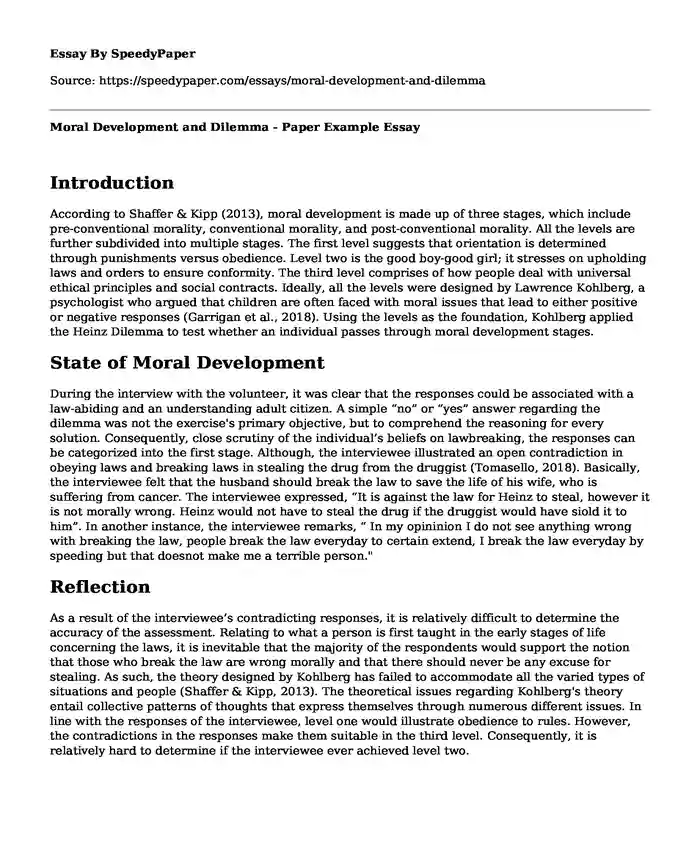
| Type of paper: | Essay |
| Categories: | Development Moral development |
| Pages: | 3 |
| Wordcount: | 666 words |
Introduction
According to Shaffer & Kipp (2013), moral development is made up of three stages, which include pre-conventional morality, conventional morality, and post-conventional morality. All the levels are further subdivided into multiple stages. The first level suggests that orientation is determined through punishments versus obedience. Level two is the good boy-good girl; it stresses on upholding laws and orders to ensure conformity. The third level comprises of how people deal with universal ethical principles and social contracts. Ideally, all the levels were designed by Lawrence Kohlberg, a psychologist who argued that children are often faced with moral issues that lead to either positive or negative responses (Garrigan et al., 2018). Using the levels as the foundation, Kohlberg applied the Heinz Dilemma to test whether an individual passes through moral development stages.
State of Moral Development
During the interview with the volunteer, it was clear that the responses could be associated with a law-abiding and an understanding adult citizen. A simple “no” or “yes” answer regarding the dilemma was not the exercise's primary objective, but to comprehend the reasoning for every solution. Consequently, close scrutiny of the individual’s beliefs on lawbreaking, the responses can be categorized into the first stage. Although, the interviewee illustrated an open contradiction in obeying laws and breaking laws in stealing the drug from the druggist (Tomasello, 2018). Basically, the interviewee felt that the husband should break the law to save the life of his wife, who is suffering from cancer. The interviewee expressed, “It is against the law for Heinz to steal, however it is not morally wrong. Heinz would not have to steal the drug if the druggist would have siold it to him”. In another instance, the interviewee remarks, “ In my opininion I do not see anything wrong with breaking the law, people break the law everyday to certain extend, I break the law everyday by speeding but that doesnot make me a terrible person."
Reflection
As a result of the interviewee’s contradicting responses, it is relatively difficult to determine the accuracy of the assessment. Relating to what a person is first taught in the early stages of life concerning the laws, it is inevitable that the majority of the respondents would support the notion that those who break the law are wrong morally and that there should never be any excuse for stealing. As such, the theory designed by Kohlberg has failed to accommodate all the varied types of situations and people (Shaffer & Kipp, 2013). The theoretical issues regarding Kohlberg's theory entail collective patterns of thoughts that express themselves through numerous different issues. In line with the responses of the interviewee, level one would illustrate obedience to rules. However, the contradictions in the responses make them suitable in the third level. Consequently, it is relatively hard to determine if the interviewee ever achieved level two.
Position
Kohlberg’s moral development theory is generally a good start at best. However, the theory does not fully settle the difference between thoughts and actions. For instance, the idea of a post-conventional morality does not perfectly correspond to social science. In most instances, a cognitive standpoint would imply that it would be more reasonable if the theory had taken into consideration the existence of independent thoughts (Tomasello, 2018). The theory seems to support the placement of an individual’s principle above the rule of law and order. Ultimately, Kohlberg’s theory can be perceived to be more culturally biased since the research mainly took into account western cultural practices; thus, consideration of other cultures may provide distinct moral views.
References
Garrigan, B., Adlam, A. L., & Langdon, P. E. (2018). Moral decision-making and moral development: Toward an integrative framework. Developmental Review, 49, 80-100. https://doi.org/10.1016/j.dr.2018.06.001
Shaffer, D. R., & Kipp, K. (2013). Developmental psychology: Childhood and adolescence. Cengage Learning.
Tomasello, M. (2018). The normative turn in early moral development. Human Development, 61(4-5), 248-263. https://www.karger.com/Article/Abstract/492802
Cite this page
Moral Development and Dilemma - Paper Example. (2023, Dec 26). Retrieved from https://speedypaper.net/essays/moral-development-and-dilemma
Request Removal
If you are the original author of this essay and no longer wish to have it published on the SpeedyPaper website, please click below to request its removal:
- Free Essay on Continuing Professional Development (CPD)
- Free Essay on the Effects of Technology in Early Childhood Education
- Free Essay: the Effects of Background Television on the Toy Play Behavior of Children
- Free Essay Sample. Parental Absence
- Free Essay: Ordinary Medicine Extraordinary Treatments, Longer Lives, and Where to Draw the Line
- Essay Sample on Nursing Informatics Tools and Technologies and Their Significance
- Emerging Curriculum. Paper Example
Popular categories




